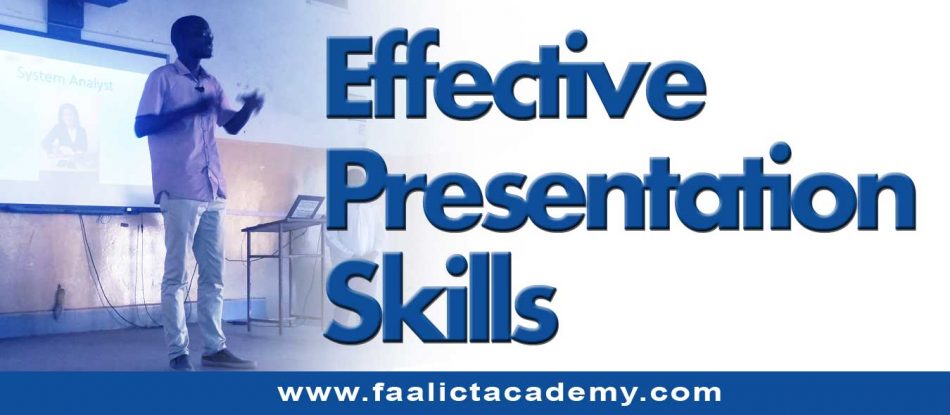Whether you’re an experienced presenter, or just starting out, there are techniques that could help you improve on your presentation skills. While it might seem quite easy to create a presentation with Microsoft PowerPoint or Apple Keynote or other presentation softwares, but creating an effective presentation requires some skills and techniques.
In this post I’ll share with you ways you could improve your presentation skills to get ready for future presentations.
How To Get Prepared
Here are few things you may need to know to get ready…
- What is the purpose of the presentation?Is it to sell, inform, support, inspire or instruct?
- To whom are you presenting?Know your audience.
- What form will the presentation take?Knowing your audience will determine the form your presentation should take.
- How much time do you have?Always plan to end early.
- Where is the presentation taking place?Is it in a hall, office, conference room or online?
- Do Your ResearchDo a thorough research on the topic you’re about to present on.
Tips To Be Covered
- Outlining
- Planning Your Presentation
- Slide Structure
- Working with Fonts
- Working with Colours
- Slide Background
- Using Visual Aids
- Using Charts
- Spelling and Grammar
- Conclusions
- Q&A
- Citation & Reference
1. Outlining
Creating an outline for your presentation gives your audience an overview of what to expect.
- Make your 1st or 2nd slide an outline of your presentationThe outline should contain a list of sub topics to cover.
- Follow the order of your outline till the end of the presentation.
- Only place main points on the outline slide.E.g. Use the titles of each slide as main points.
2. Planning
- Gather your information before putting them into your presentation software.E.g. You can use a Word Processor like Microsoft Word.
- Create a unique design for your presentation.Presentation softwares usually have pre-built template designs, but always try to create your own design or modify an existing one to suit your brand or needs.
3. “Good” Slide Structure
 Show one point at a time:Will help audience concentrate on what you are saying.
Show one point at a time:Will help audience concentrate on what you are saying.
-
- Will prevent audience from reading ahead.
- Will help you keep your presentation focused.
“Bad” Slide Structure
 Do not use distracting animations.
Do not use distracting animations.
- Do not go overboard with the animation.
- Be consistent with the animation you use.
4. “Good” Fonts
 Avoid backgrounds that are distracting or difficult to read from.
Avoid backgrounds that are distracting or difficult to read from.
- Always be consistent with the background you use.
7. “Good” Visual Aids
 Use visuals aides like photos or videos and not just words to make your information more meaningful and could double the chance of meeting your goals.
Use visuals aides like photos or videos and not just words to make your information more meaningful and could double the chance of meeting your goals.
- Only use visual aids if necessary.
8. Charts
- Use charts and not just words to make it more meaningful.
- Data in charts is easier to comprehend & retain than raw data.
- Always title your Charts.
“Good” Chart
Proof read your slides for:
- spelling mistakes
- the use of repeated words
- grammatical errors you might have made
- You can also find someone else check your presentation for errors.
10. Conclusion
- Use an effective and strong closing.
- Your audience are likely to remember your last words.
- Use a conclusion slide to: Summarize the main points of your presentation.
-
- Suggest future avenues of research.
11. Q&A?
End your presentation with a simple question slide to:
- Invite your audience to ask questions to test their understanding.
- Avoid ending a presentation unexpectedly.
12. Citation & Reference
Cite any information from other sources you mentioned within your points and place a reference slide at end of the presentation.
Final tips
- Practice! Practice! But don’t memorize.
- Speak loud and clear.
- Keep it short – make your presentation short and precise.
- Be confident.
- Look into the eyes of your audience – one technique I use when presenting is by moving my eyes from audience to another to keep them focus.
- Tell stories or experiences – it helps illustrate points and makes your presentation more effective and memorable.
- Avoid being verbose or wordy.
- Give out handouts after the presentation if necessary.
- Inspire your audience.
- Reading directly from your slides decreases credibility.
- If possible, ask someone to take a video of you – looking at yourself in a video could help you examine your body language and the way you speak.
- Always know what’s on the next slide to smoothly transition into it with power.
- Have a backup – get a copy of your presentation on different formats, on a USB drive or CD or even a printed copy just in case something goes wrong.
Always remember that you’re the presentation not the software, the software is just a tool to help you present. I hope these tips and techniques were helpful, try to adapt them to improve on your presentation skills and get ready for future presentations.
Ousman Faal [Digital Vigilante] is a Tech Entrepreneur & Digital Skills Trainer who teaches both in the classroom and online. He has experience in various technologies and likes sharing it with others. Ousman has published 149 articles on this blog. He is the CEO of Faalen Technologies and Skills.gm.










